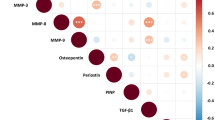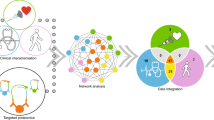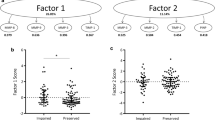Abstract
Chemokines are involved in the remodeling of the heart; however, their significance as biomarkers in heart failure is unknown. We observed that circulating CXCR3 receptor chemokines CXCL9 and CXCL10 in a rat model of heart failure were increased 1 week after myocardial infarction. CXCL10 was also increased in both remote and infarcted regions of the heart and remained elevated at 16 weeks; CXCL9 was elevated in the remote area at 1 week. In humans, hierarchical clustering and principal component analysis revealed that circulating CXCL10, MIP-1α, and CD40 ligand were the best indicators for differentiating healthy and heart failure subjects. Serum CXCL10 levels were increased in patients with symptomatic heart failure as indexed by NYHA classification II through IV. The presence of CXCL10, MIP-1α, and CD40 ligand appears to be dominant in patients with advanced heart failure. These findings identify a distinct profile of inflammatory mediators in heart failure patients.










Similar content being viewed by others
Abbreviations
- ACCF/AHA:
-
American College of Cardiology Foundation/American Heart Association
- BNP:
-
B-type natriuretic peptide
- CD40:
-
Cluster of differentiation 40
- CXCL:
-
Chemokine (C-X-C motif) ligand
- CXCR:
-
Chemokine (C-X-C motif) receptor
- FLEMENGHO:
-
Flemish Study on Environment, Genes, and Health Outcomes
- HF:
-
Heart failure
- IFN-γ:
-
Interferon gamma
- IL:
-
Interleukin
- IP-10:
-
Interferon gamma-induced protein 10
- LAD:
-
Left anterior descending artery
- LV:
-
Left ventricle/ventricular
- MCP1:
-
Monocyte chemoattractant protein 1
- MI:
-
Myocardial infarction
- MIF:
-
Macrophage migration inhibitory factor
- MIP-1α:
-
Macrophage inflammatory protein-1 alpha
- NYHA:
-
New York Heart Association
- NT-proBNP:
-
N-terminal of the prohormone brain natriuretic peptide
- PCA:
-
Principal component analysis
- SDF1:
-
Stromal cell-derived factor 1
- TIMP-1:
-
Tissue inhibitor of metalloproteinases-1
- TNFα:
-
Tumor necrosis factor alpha
- TRIUMPH:
-
TRanslational Initiative on Unique and novel strategies for Management of Patients with Heart failure
References
Sidney, S., Rosamond, W. D., Howard, V. J., Luepker, R. V., National Forum for Heart, D, & Stroke, P. (2013). The “heart disease and stroke statistics--2013 update” and the need for a national cardiovascular surveillance system. Circulation, 127(1), 21–23. doi:10.1161/CIRCULATIONAHA.112.155911.
Moreno, V., Hernandez-Romero, D., Vilchez, J. A., Garcia-Honrubia, A., Cambronero, F., Casas, T., et al. (2010). Serum levels of high-sensitivity troponin T: a novel marker for cardiac remodeling in hypertrophic cardiomyopathy. Journal of Cardiac Failure, 16(12), 950–956. doi:10.1016/j.cardfail.2010.07.245.
Gaggin, H. K., & Januzzi, J. L., Jr. (2013). Biomarkers and diagnostics in heart failure. Biochimica et Biophysica Acta, 1832(12), 2442–2450. doi:10.1016/j.bbadis.2012.12.014.
Montoro-Garcia, S., Hernandez-Romero, D., Jover, E., Garcia-Honrubia, A., Vilchez, J. A., Casas, T., et al. (2012). Growth differentiation factor-15, a novel biomarker related with disease severity in patients with hypertrophic cardiomyopathy. European Journal of Internal Medicine, 23(2), 169–174. doi:10.1016/j.ejim.2011.08.022.
Maisel, A., Mueller, C., Nowak, R., Peacock, W. F., Landsberg, J. W., Ponikowski, P., et al. (2010). Mid-region pro-hormone markers for diagnosis and prognosis in acute dyspnea: results from the BACH (Biomarkers in Acute Heart Failure) trial. Journal of the American College of Cardiology, 55(19), 2062–2076. doi:10.1016/j.jacc.2010.02.025.
Pfisterer, M., Buser, P., Rickli, H., Gutmann, M., Erne, P., Rickenbacher, P., et al. (2009). BNP-guided vs symptom-guided heart failure therapy: the Trial of Intensified vs Standard Medical Therapy in Elderly Patients with Congestive Heart Failure (TIME-CHF) randomized trial. JAMA, 301(4), 383–392. doi:10.1001/jama.2009.2.
Dickstein, K., Cohen-Solal, A., Filippatos, G., McMurray, J. J., Ponikowski, P., & Poole-Wilson, P. A. (2008). ESC guidelines for the diagnosis and treatment of acute and chronic heart failure 2008: the Task Force for the diagnosis and treatment of acute and chronic heart failure 2008 of the European Society of Cardiology. Developed in collaboration with the Heart Failure Association of the ESC (HFA) and endorsed by the European Society of Intensive Care Medicine (ESICM). European Journal of Heart Failure, 10(10), 933–989. doi:10.1016/j.ejheart.2008.08.005.
Desai, A. S. (2013). Are serial BNP measurements useful in heart failure management? Serial natriuretic peptide measurements are not useful in heart failure management: the art of medicine remains long. Circulation, 127(4), 509–516. doi:10.1161/CIRCULATIONAHA.112.120493. discussion 516.
Rodeheffer, R. J. (2004). Measuring plasma B-type natriuretic peptide in heart failure: good to go in 2004? Journal of the American College of Cardiology, 44(4), 740–749. doi:10.1016/j.jacc.2004.03.082.
Richards, A. M. (2007). Variability of NT-proBNP levels in heart failure: implications for clinical application. Heart, 93(8), 899–900. doi:10.1136/hrt.2006.110643.
Boerrigter, G., Costello-Boerrigter, L. C., & Burnett, J. C., Jr. (2009). Natriuretic peptides in the diagnosis and management of chronic heart failure. Heart Failure Clinics, 5(4), 501–514. doi:10.1016/j.hfc.2009.04.002.
Madamanchi, C., Alhosaini, H., Sumida, A., & Runge, M. S. (2014). Obesity and natriuretic peptides, BNP and NT-proBNP: mechanisms and diagnostic implications for heart failure. International Journal of Cardiology, 176(3), 611–617. doi:10.1016/j.ijcard.2014.08.007.
Writing Committee, M., Yancy, C. W., Jessup, M., Bozkurt, B., Butler, J., Casey, D. E., Jr., et al. (2013). 2013 ACCF/AHA guideline for the management of heart failure: a report of the American College of Cardiology Foundation/American Heart Association Task Force on practice guidelines. Circulation, 128(16), e240–327. doi:10.1161/CIR.0b013e31829e8776.
Altara, R., Gu, Y. M., Struijker-Boudier, H. A., Thijs, L., Staessen, J. A., & Blankesteijn, W. M. (2015). Left ventricular dysfunction and CXCR3 ligands in hypertension: from animal experiments to a population-based pilot study. PloS One, 10(10), e0141394. doi:10.1371/journal.pone.0141394.
Altara, R., Manca, M., Brandao, R.D., Zeidan, A., Booz, G.W., & zouein, F. A. (2016). Emerging importance of chemokine receptor CXCR3 and its ligands in cardiovascular diseases. Clinical Science (London, England: 1979), 130(7).
Daskalopoulos, E.P., Vilaeti, A.D., Barka, E., Mantzouratou, P., Kouroupis, D., Kontonika, M., et al. (2015). Attenuation of post-infarction remodeling in rats by sustained myocardial growth hormone administration. Growth Factors:1–9.
Higuchi, T., Nekolla, S. G., Jankaukas, A., Weber, A. W., Huisman, M. C., Reder, S., et al. (2007). Characterization of normal and infarcted rat myocardium using a combination of small-animal PET and clinical MRI. Journal of Nuclear Medicine, 48(2), 288–294.
Kuznetsova, T., Mischak, H., Mullen, W., & Staessen, J. A. (2012). Urinary proteome analysis in hypertensive patients with left ventricular diastolic dysfunction. European Heart Journal, 33(18), 2342–2350. doi:10.1093/eurheartj/ehs185.
Kuznetsova, T., Herbots, L., Lopez, B., Jin, Y., Richart, T., Thijs, L., et al. (2009). Prevalence of left ventricular diastolic dysfunction in a general population. Circulation. Heart Failure, 2(2), 105–112. doi:10.1161/CIRCHEARTFAILURE.108.822627.
Altara, R., Manca, M., Hessel, M. H., Janssen, B. J., Struijker-Boudier, H. H., Hermans, R. J., et al. (2014). Improving membrane based multiplex immunoassays for semi-quantitative detection of multiple cytokines in a single sample. BMC Biotechnology, 14, 63. doi:10.1186/1472-6750-14-63.
Battes, L. C., Caliskan, K., Rizopoulos, D., Constantinescu, A. A., Robertus, J. L., Akkerhuis, M., et al. (2015). Repeated measurements of NT-pro-B-type natriuretic peptide, troponin T or C-reactive protein do not predict future allograft rejection in heart transplant recipients. Transplantation, 99(3), 580–585. doi:10.1097/TP.0000000000000378.
Bernhard, O. K., Mathias, R. A., Barnes, T. W., & Simpson, R. J. (2011). A fluorescent microsphere-based method for assay of multiple analytes in plasma. Methods in Molecular Biology, 728, 195–206. doi:10.1007/978-1-61779-068-3_12.
Huynh, K., Van Tassell, B., & Chow, S. L. (2015). Predicting therapeutic response in patients with heart failure: the story of C-reactive protein. Expert Review of Cardiovascular Therapy, 13(2), 153–161. doi:10.1586/14779072.2015.1000307.
Savarese, G., Rosano, G. M., Parente, A., D’Amore, C., Reiner, M. F., Camici, G. G., et al. (2014). Reduction of C-reactive protein is not associated with reduced cardiovascular risk and mortality in patients treated with statins. A meta-analysis of 22 randomized trials. International Journal of Cardiology, 177(1), 152–160. doi:10.1016/j.ijcard.2014.09.028.
Altara, R., Manca, M., Sabra, R., Eid, A. A., Booz, G. W., & Zouein, F. A. (2015). Temporal cardiac remodeling post-myocardial infarction: dynamics and prognostic implications in personalized medicine. Heart Failure Reviews. doi:10.1007/s10741-015-9513-8.
Schoemaker, R. G., Debets, J. J., Struyker-Boudier, H. A., & Smits, J. F. (1991). Delayed but not immediate captopril therapy improves cardiac function in conscious rats, following myocardial infarction. Journal of Molecular and Cellular Cardiology, 23(2), 187–197.
Yan, X., Shichita, T., Katsumata, Y., Matsuhashi, T., Ito, H., Ito, K., et al. (2012). Deleterious effect of the IL-23/IL-17A axis and gammadeltaT cells on left ventricular remodeling after myocardial infarction. Journal of the American Heart Association, 1(5), e004408. doi:10.1161/JAHA.112.004408.
Raphael, C., Briscoe, C., Davies, J., Ian Whinnett, Z., Manisty, C., Sutton, R., et al. (2007). Limitations of the New York Heart Association functional classification system and self-reported walking distances in chronic heart failure. Heart, 93(4), 476–482. doi:10.1136/hrt.2006.089656.
Goldman, L., Hashimoto, B., Cook, E. F., & Loscalzo, A. (1981). Comparative reproducibility and validity of systems for assessing cardiovascular functional class: advantages of a new specific activity scale. Circulation, 64(6), 1227–1234.
Altara, R., Manca, M., Hermans, K. C., Daskalopoulos, E. P., Brunner-La Rocca, H. P., Hermans, R. J., et al. (2015). Diurnal rhythms of serum and plasma cytokine profiles in healthy elderly individuals assessed using membrane based multiplexed immunoassay. Journal of Translational Medicine, 13, 129. doi:10.1186/s12967-015-0477-1.
Blossom, S. J., Rau, J. L., Best, T. H., Bornemeier, R. A., & Hobbs, C. A. (2013). Increased maternal cytokine production and congenital heart defects. Journal of Reproductive Immunology, 97(2), 204–210. doi:10.1016/j.jri.2012.12.004.
Fujiu, K., Wang, J., & Nagai, R. (2014). Cardioprotective function of cardiac macrophages. Cardiovascular Research, 102(2), 232–239. doi:10.1093/cvr/cvu059.
Hausding, M., Jurk, K., Daub, S., Kroller-Schon, S., Stein, J., Schwenk, M., et al. (2013). CD40L contributes to angiotensin II-induced pro-thrombotic state, vascular inflammation, oxidative stress and endothelial dysfunction. Basic Research in Cardiology, 108(6), 386. doi:10.1007/s00395-013-0386-5.
Kaptoge, S., Seshasai, S. R., Gao, P., Freitag, D. F., Butterworth, A. S., Borglykke, A., et al. (2014). Inflammatory cytokines and risk of coronary heart disease: new prospective study and updated meta-analysis. European Heart Journal, 35(9), 578–589. doi:10.1093/eurheartj/eht367.
Fu, W., Zhu, J., Qiu, Y., & Li, W. (2013). Induction of CD4 + CD25+ T cells and control of cardiac allograft rejection by CD40/CD40L costimulatory pathway blockade in mice. Transplantation Proceedings, 45(2), 611–617. doi:10.1016/j.transproceed.2012.10.044.
Krill, K. T., Csencsits-Smith, K., Wood, S. C., Faust, S., Lu, G., & Bishop, D. K. (2013). Glucocorticoid-induced TNFR-related protein stimulation reverses cardiac allograft acceptance induced by CD40-CD40L blockade. Clinical & Developmental Immunology, 2013, 986859. doi:10.1155/2013/986859.
Krintus, M., Kozinski, M., Kubica, J., & Sypniewska, G. (2014). Critical appraisal of inflammatory markers in cardiovascular risk stratification. Critical Reviews in Clinical Laboratory Sciences, 51(5), 263–279. doi:10.3109/10408363.2014.913549.
Acknowledgments
The authors would like to thank Dr. F.A. Zouein for the thoughtful discussion on this study. We are appreciative of the outstanding contribution of Dr. Joke Orsel in helping with the ELISA assay.
Author information
Authors and Affiliations
Corresponding author
Ethics declarations
Conflict of Interest
The authors declare that they have no conflict of interest.
Human Subjects/Informed Consent
The recruitment of subjects was performed according to the Medical Ethical Committees of Groningen and Maastricht University, The Netherlands, and in accordance with of the Declaration of Helsinki of 1975.
Animal Studies
All experimental and surgical procedures were approved by the Institutional Council on Animal Care and Use of the Maastricht University and complied with the National Institutes of Health Guide for the Care and Use of Laboratory Animals.
Sources of Funding
This research was performed within the framework of CTMM, the Center for Translational Molecular Medicine (www.ctmm.nl), project TRIUMPH grant 01C-103, and supported by the Dutch Heart Foundation.
Additional information
Associate Editor Enrique Lara-Pezzi oversaw the review of this article
Electronic Supplementary Material
Below is the link to the electronic supplementary material.
Supplementary Figure 1
Shown are the cytokines that were most increased in terms of fold-change for heart failure patients enrolled in the TRIUMPH cohort compared to healthy individuals. Serum levels of the cytokines were analyzed by multiplex membrane-based immunoassay. (PDF 80 kb)
Supplementary Figure 2
A scatter plot showing the correlation between the ELISA and membrane-based assay for CXCL10 determination in TRIUMPH patients. (PDF 36 kb)
Supplementary Figure 3a
No difference was observed between ischemic and non-ischemic heart failure patients enrolled in the TRIUMPH cohort in either (A) CXCL10 or (B) NT-proBNP levels. Data are shown as box and whiskers plots according to the Tukey method. (PDF 39 kb)
Supplementary Figure 3b
(PDF 41 kb)
Supplementary Table 1
Shown are the loading values for component 1 and 2 determined from the principal component analysis of the circulating inflammatory profile of heart failure patients from the TRIUMPH cohort compared to healthy subjects. (DOCX 23 kb)
Rights and permissions
About this article
Cite this article
Altara, R., Manca, M., Hessel, M.H. et al. CXCL10 Is a Circulating Inflammatory Marker in Patients with Advanced Heart Failure: a Pilot Study. J. of Cardiovasc. Trans. Res. 9, 302–314 (2016). https://doi.org/10.1007/s12265-016-9703-3
Received:
Accepted:
Published:
Issue Date:
DOI: https://doi.org/10.1007/s12265-016-9703-3




